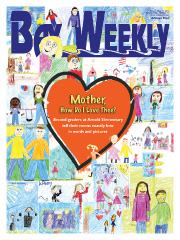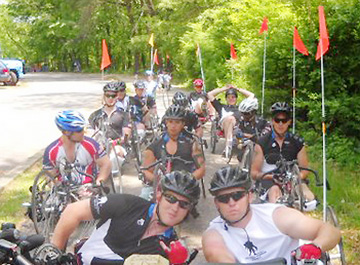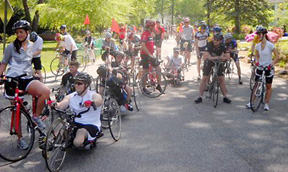Chesapeake Bay's Independent Newspaper ~ Since 1993
1629 Forest Drive, Annapolis, MD 21403 ~ 410-626-9888
Volume xviii, Issue 18 ~ May 6 to May 12, 2010
Home \\ Correspondence \\ from the Editor \\ Submit a Letter \\ Classifieds \\ Contact Us
Best of the Bay \\ Dining Guide \\ Home & Garden Guide \\ Archives \\ Distribution \\ Advertising![]()


 |
Where We Liveby Steve Carr |
How the Wounded Warriors Ride
With pride and on some marvels of compassionate ingenuity

On its fourth and last day, the Wounded Warrior Project’s Soldier Ride from the White House to the Lighthouse passes through Annapolis. The goal of the ride is to rehabilitate soldiers severely wounded in mind and body.
This is my third year guiding the 35 wounded vets around the narrow streets of Annapolis. Half of our riders have lost at least one limb, and many have lost both legs. For most of the riders, this is a first foray back into normal life. Their first test is a hard one.
The journey begins with a 20-mile ride through Washington and Arlington Cemetery. Day two, they ride through the streets of Baltimore, hosted by Under Armour, ending with an Orioles game. This year, the Birds played the Yankees. Day three 2010 was a hot and difficult 33-mile ride from Andrews Air Force Base to Annapolis, with a crab feast at Mike’s Crab House sponsored by Boston Scientific. The final day we did a 21-mile romp through Annapolis, ending at Armadillos, where owner Brendan Fisher pulled out all the stops for the tired riders.
Riding this year were two amputees who had lost their legs less than two months ago in Iraq. But this is not a pity party. None of the riders want you to feel sorry for them. The Soldier Ride is a journey that leads from the hospital bed at Walter Reed to a brave new life wherever they call home. They want only respect.
The logistics of a Soldier Ride are mind-numbingly complicated. U-Haul, the major sponsor, provides the trucks that haul the bikes and gear around and support the riders at every stop.
TREK bicycles provides helmets, shirts and tricked-out bikes for those riders who can handle a standard bicycle.
How can people who have had their legs blown off ride a bike?
Two vendors supply the basic prototypes: ICE Trikes out of Great Britain and Catrike out of Florida. These are low-rider tricycles with hand cranks outfitted with special brakes, gears and steering column.
The bikes are then handed off to a company called Creative Mobility out of St. Charles, Illinois, owned by a Hallmark Hero named Hal Honeyman. Hal started his business in 1975, and when his son Jacob was born with cerebral palsy he began a quest to give his handicapped son a way to be like other kids and ride a bike. This led him to design special $2,000 to $5,000 bikes that allow mobility for anyone, no matter their disability.
“Every person we run into has a different set of strengths and weaknesses, and our job is to find their strengths,” Honeyman explains. “They might be able to use their arms, or legs or any portion of that, and we identify the things that they can use to get out and ride and be successful.”
Eight regional Soldier Rides span the United States each year, and Hal attends every one and tailors each bike for the needs of each soldier — who is like a unique fingerprint and presents a special technical problem. Hal works with the physical therapists at Walter Reed, making sure that every wounded warrior rides the proper bike. 
At the end of our final ride on Saturday, Hal asked me about the Alex Haley/Kunta Kinte Memorial at the City Dock. I explained Annapolis’ slave-trading past, and we looked at the storyboards that tell the tale of lost lives and perseverance. It was a story Hal could relate to.
“Every day that I come to work or do a Soldier Ride, I get to see someone become mobile,” he told me. “And mobility opens the doors to independence and greater self-esteem.”
Then we both cried.
The Soldier Ride will do that to you. It teaches you that no matter what curves life throws at you, you can’t give up.
I asked Hal if he had ever encountered a veteran who was so badly maimed that he couldn’t be outfitted on a bike?
“Only one. We have a veteran at Walter Reed who has lost all or portions of all four limbs. We haven’t figured out how to get him on a bike yet. But we will.”
Let us all hope and pray this valiant soldier can ride with us next year.